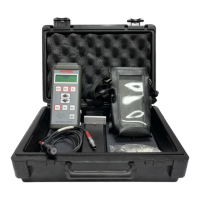different distribution of energy within layers of differ-
ent conductivity. Care must be taken to always mea-
sure such materials at the same frequency (usually
60 kHz).
The conductivity of a material changes considerably
with temperature, but is normally specifi ed at 20 °C.
The AutoSigma 3000 indicates the materials 20 °C
conductivity value by applying a standard correction
algorithm, valid for the most common aluminium al-
loys. For the best accuracy, the instrument, material to
be tested, probe, and calibration standards should be
at the same temperature, close to 20 °C.
Other key factors are coating thickness/lift-off and ma-
terial curvature.
Measurements can be made through layers of paint
or other non-conductive coatings up to a thickness of
0.020" (0.5 mm) with the 12.7 mm probe and 0.010"
(0.25 mm) with the 8 mm probe.
Use on curved surfaces requires some caution, with
concave surfaces the effect is primarily lift-off and the
instrument will compensate up to the point where the
spacing of the centre of the probe from the material
becomes excessive. With convex surfaces the indicat-
ed conductivity will decrease as the radius decreases.
Correction tables are required for radii below approxi-
mately 3" (75 mm).
To ensure proper operation the calibration standards,
instruments and probes should be checked and recali-
brated on a regular basis (e.g. check on standards be-
fore each use and factory re-calibration every year).
Basic measurement knowledge
Preparation for operation
3 - 10
Issue 04, 06/2007 AutoSigma 3000

